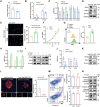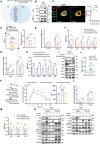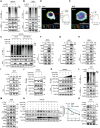Beta-Cell Tipe1 Orchestrates Insulin Secretion and Cell Proliferation by Promoting Gαs/cAMP Signaling via USP5
- PMID: 38417114
- PMCID: PMC11040358
- DOI: 10.1002/advs.202304940
Beta-Cell Tipe1 Orchestrates Insulin Secretion and Cell Proliferation by Promoting Gαs/cAMP Signaling via USP5
Abstract
Inadequate β-cell mass and insulin secretion are essential for the development of type 2 diabetes (T2D). TNF-α-induced protein 8-like 1 (Tipe1) plays a crucial role in multiple diseases, however, a specific role in T2D pathogenesis remains largely unexplored. Herein, Tipe1 as a key regulator in T2D, contributing to the maintenance of β cell homeostasis is identified. The results show that the β-cell-specific knockout of Tipe1 (termed Ins2-Tipe1BKO) aggravated diabetic phenotypes in db/db mice or in mice with high-fat diet-induced diabetes. Notably, Tipe1 improves β cell mass and function, a process that depends on Gαs, the α subunit of the G-stimulating protein. Mechanistically, Tipe1 inhibited the K48-linked ubiquitination degradation of Gαs by recruiting the deubiquitinase USP5. Consequently, Gαs or cAMP agonists almost completely restored the dysfunction of β cells observed in Ins2-Tipe1BKO mice. The findings characterize Tipe1 as a regulator of β cell function through the Gαs/cAMP pathway, suggesting that Tipe1 may emerge as a novel target for T2D intervention.
Keywords: Gαs ubiquitination; Tipe1; deubiquitinase USP5; diabetes; islet β cell.
© 2024 The Authors. Advanced Science published by Wiley‐VCH GmbH.
Conflict of interest statement
The authors declare no conflict of interest.
Figures






Similar articles
-
RNA m6A reader IMP2/IGF2BP2 promotes pancreatic β-cell proliferation and insulin secretion by enhancing PDX1 expression.Mol Metab. 2021 Jun;48:101209. doi: 10.1016/j.molmet.2021.101209. Epub 2021 Mar 9. Mol Metab. 2021. PMID: 33705986 Free PMC article.
-
Elovl6 Deficiency Improves Glycemic Control in Diabetic db/db Mice by Expanding β-Cell Mass and Increasing Insulin Secretory Capacity.Diabetes. 2017 Jul;66(7):1833-1846. doi: 10.2337/db16-1277. Epub 2017 May 1. Diabetes. 2017. PMID: 28461456
-
Characterization of Signaling Pathways Associated with Pancreatic β-cell Adaptive Flexibility in Compensation of Obesity-linked Diabetes in db/db Mice.Mol Cell Proteomics. 2020 Jun;19(6):971-993. doi: 10.1074/mcp.RA119.001882. Epub 2020 Apr 7. Mol Cell Proteomics. 2020. PMID: 32265294 Free PMC article.
-
Modulation of β-cell function: a translational journey from the bench to the bedside.Diabetes Obes Metab. 2012 Oct;14 Suppl 3:152-60. doi: 10.1111/j.1463-1326.2012.01647.x. Diabetes Obes Metab. 2012. PMID: 22928576 Review.
-
Oxytocin is present in islets and plays a role in beta-cell function and survival.Peptides. 2018 Feb;100:260-268. doi: 10.1016/j.peptides.2017.12.019. Epub 2017 Dec 20. Peptides. 2018. PMID: 29274352 Review.
Cited by
-
Prenylation-dependent membrane localization of a deubiquitinating enzyme and its role in regulating G protein-mediated signaling in yeast.J Biol Chem. 2025 Feb;301(2):108180. doi: 10.1016/j.jbc.2025.108180. Epub 2025 Jan 10. J Biol Chem. 2025. PMID: 39798877 Free PMC article.
-
Unlocking the Potential of Collagenases: Structures, Functions, and Emerging Therapeutic Horizons.Biodes Res. 2024 Oct 8;6:0050. doi: 10.34133/bdr.0050. eCollection 2024. Biodes Res. 2024. PMID: 39381623 Free PMC article.
-
Deubiquitinase USP5 regulates RIPK1 driven pyroptosis in response to myocardial ischemic reperfusion injury.Cell Commun Signal. 2024 Sep 30;22(1):466. doi: 10.1186/s12964-024-01853-x. Cell Commun Signal. 2024. PMID: 39350285 Free PMC article.
References
-
- Eizirik D. L., Pasquali L., Cnop M., Nat. Rev. Endocrinol. 2020, 16, 349. - PubMed
Publication types
MeSH terms
Substances
Grants and funding
LinkOut - more resources
Full Text Sources
Medical
Miscellaneous
